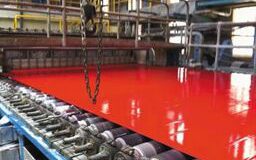Trailer Flooring Makes a Difference in Paper Roll Transport

JOHN VOZNIAK, ET. AL.
 In North America, truck-trailers transport approximately 70 percent of the goods on highways and roads, but not all trailers can haul paper rolls. The structural features of dry freight van trailers are designed by the trailer manufacturers to meet the requirements of each fleet’s operating environment. These requirements vary widely depending on the type of freight a fleet is transporting. General palletized goods, boxes/packages, beverages, automotive parts, and paper rolls are some of the diverse types of freight that fleets transport.
In North America, truck-trailers transport approximately 70 percent of the goods on highways and roads, but not all trailers can haul paper rolls. The structural features of dry freight van trailers are designed by the trailer manufacturers to meet the requirements of each fleet’s operating environment. These requirements vary widely depending on the type of freight a fleet is transporting. General palletized goods, boxes/packages, beverages, automotive parts, and paper rolls are some of the diverse types of freight that fleets transport.
Among these, paper rolls are the most challenging to transport safely. A single paper roll can weigh 8,000 lb, which makes it one of the most demanding types of freight hauled by a dry freight van. A trailer designed to haul lightweight packages is not structurally suited to haul paper rolls. When hauling paper rolls, the trailer also needs to be free of water leaks to prevent damage to the paper.
CHALLENGES OF
TRANSPORTING PAPER ROLLS
Freight rests on the trailer’s flooring, so flooring is a critical part of the trailer floor system. Conventional trailer flooring is typically comprised of eight, 15/16 -inch thick laminated oak boards, which are installed side-by-side in the trailer.
The floorboards are laid along the length of the trailer and supported underneath by four-inch-tall cross-members. The floorboards are fastened to the top flanges of the cross-members with screws. Cross-members are connected to the side rails of the trailer. The flooring, cross-members, and their connections form a trailer’s floor system.
 The trailer manufacturer assigns a floor system load rating based on the results of an industry standard test protocol. According to industry standard practice, only the trailer manufacturer shall assign a load rating to the floor system.
The trailer manufacturer assigns a floor system load rating based on the results of an industry standard test protocol. According to industry standard practice, only the trailer manufacturer shall assign a load rating to the floor system.
When shippers load paper rolls into a trailer at the dock using a clamp truck, most of the combined weight of the clamp truck and the paper roll is transferred from the front axle wheels of the clamp truck to the floor system. For example, a paper roll weighing 8,000 lb may be loaded into a trailer by a clamp truck weighing 20,000 lb. (total weight of the clamp and truck). The total weight of the paper roll and clamp truck is 28,000 lb. In this example, the floor system will likely experience a concentrated load of approximately 25,000 lb. However, most trailers are not built to meet this load requirement.
The transportation of paper rolls can be extraordinarily stressful on trailer floor systems. The effects of the front axle load on the floor, combined with the number of loading and unloading cycles, can result in premature damage to flooring that is not built for hauling paper. The photo above shows typical structural damage at the bottom side of a conventional wood floor with cross-members at 12-inch spacing. Fatigue fracture and cracking of wood results in pathways for water to enter the trailer through the floor, further compounding the issue. Load transfer from the flooring to cross-members is adversely affected as the floor boards weaken. If cross-members are spaced closer to address this problem, the floor system can receive higher load ratings, but the trailer also gets heavier, adding inefficiencies. What can be done to address the challenges faced by fleets and paper mills for safely transporting paper rolls without increasing the weight of the trailer?
IMPROVING FLOOR PERFORMANCE
To improve the performance of conventional laminated oak flooring for trailers, trailer flooring manufacturer Havco Wood Products, Scott City, MO, has developed a composite floor product called Fusion Floor by Havco. The product is made by bonding a high-strength glass fiber reinforced epoxy composite sheet to the underside of the floorboards. Fusion Floor has been installed in more than 250,000 trailers in the past 17 years. Several truckload carriers and dedicated fleets have adopted Fusion Floor for their trailers to haul paper and a variety of other freight in their back haul.
 Smith Transport in Roaring Spring, PA, was an early adopter of Fusion Floor. “At Smith Transport we’ve been a leader in transportation of paper rolls for 35 years. We strive to not only meet our customer’s high expectations, but exceed them,” says VP of Logistics Dane Smith. “For more than 15 years, Fusion Floor by Havco is the only product we have relied on. It’s not just the strength, quality, and performance; the lighter weight allows us to carry more product, which over time is a tremendous cost savings to our customers.”
Smith Transport in Roaring Spring, PA, was an early adopter of Fusion Floor. “At Smith Transport we’ve been a leader in transportation of paper rolls for 35 years. We strive to not only meet our customer’s high expectations, but exceed them,” says VP of Logistics Dane Smith. “For more than 15 years, Fusion Floor by Havco is the only product we have relied on. It’s not just the strength, quality, and performance; the lighter weight allows us to carry more product, which over time is a tremendous cost savings to our customers.”
Fusion Floor  has twice the strength of a conventional wood floor at the same flooring thickness. It provides increased durability, longer life, and reduced cost of maintenance by resisting damaging effects of load cycles. Fusion Floor is lighter by up to 360 lb per trailer when compared to a conventional wood floor with a similar load rating. The glass/epoxy composite reinforcement sheet in Fusion Floor weighs 1/2 lb per square foot, is approximately 1/16 inch thick and is 10 times stronger than wood.
has twice the strength of a conventional wood floor at the same flooring thickness. It provides increased durability, longer life, and reduced cost of maintenance by resisting damaging effects of load cycles. Fusion Floor is lighter by up to 360 lb per trailer when compared to a conventional wood floor with a similar load rating. The glass/epoxy composite reinforcement sheet in Fusion Floor weighs 1/2 lb per square foot, is approximately 1/16 inch thick and is 10 times stronger than wood.
The high-strength composite layer is bonded to the laminated oak board with high-quality hot-melt polyurethane (PUR) adhesive. It allows load ratings in excess of 24,000 lb using cross-member spacing of 10 or 12 inches, thus saving the weight and cost of additional cross-members. Due to its strength, stiffness and fatigue resistance, Fusion Floor spreads loads over more cross-members, which increases the life of the trailer. Another important benefit of Fusion Floor is its impermeability to roadside water. This protects the freight on the topside of the floor by preventing roadside moisture from migrating through the underside of the floorboards.
Transporting heavy paper rolls requires a trailer floor system designed and built to do the job. Fusion Floor incorporates best-in-class glass/epoxy reinforcement and excellent bonding of the composite sheet to oak floor-boards. It provides high strength, long life and durability, improved load distribution on the cross-members, superior moisture protection, lighter overall weight, proven performance over the years, and higher trade-in value—all the necessary characteristics for safely transporting paper rolls.
Authors John Vozniak, John Carr, Clark Johnson, and Chuck Bostic are with Havco Wood Products, LLC. Founded in 1978, Havco manufactures oak flooring and Fusion Floor composite flooring for trailers, truck bodies, and containers. Havco operates manufacturing facilities in Cape Girardeau, MO, and Vonore, TN. Learn more at havco.com.
Typical fatigue fracture and cracking of a conventional wood floor.
A clamp truck ready for loading a paper roll into a trailer.
The typical flooring layout in a dry van trailer.
Construction details of Fusion Floor.
A dry freight van trailer designed for transporting paper.




